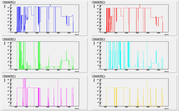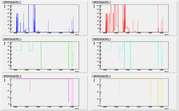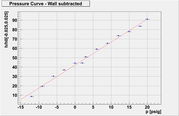Meeting No.4: T3 - Asymmetry (GMn) #3
Prescale Factors:
The following plots show how the prescale factors change with the run numbers. This time I have also added
a plot of the HRSR-prescales.


T3- ratios:

Ratios between equivalent event types that have/don't have T3 entry (due to the prescale factors) are:
EventType Bits | Ratio
------------------------------
32 / 40 | 3.493
64 / 72 | 3.423
96 / 104 | 3.476
We can see that the ratio between the "equivalent events" that have T3 and those
that do not have T3 is not five (T3 prescale factor was set to 5) but is a bit smaller. Why?
#2641 End-of-run Halog Entry
PRESCALE FACTORS:ps1=16777215 ps2=16777215 ps3=5 ps4=4 ps5=1 ps6=1 ps7=65535 ps8=100
EVENTS : [ 0]: 4004671 [++]: 0 [--]: 1979590 [+-]: 0 [-+]: 1966956
TIME : [ 0]: 33.010 mins [++]: 0.017 mins [--]: 16.290 mins [+-]: 0.017 mins [-+]: 16.298 mins
Test of Helicity gates
Time diff of helicity to nonhelicity times = 986.33221 seconds
LIVE calc. crudely accounts for correlations. Need offline calc.
DEAD TIME: [ 0]: 6.90% [++]: 0.00% [--]: 6.88% [+-]: 0.00% [-+]: 6.84%
TRIGGER RATES: PRES/REAL
T1[ 0] : 0.0/237695.9 Hz T2[ 0] : 0.0/205533.1 Hz T3[ 0] :1539.8/7699.1 Hz T4[ 0] :39.3/157.2 Hz T5[ 0] :828.0/828.0 Hz T6[ 0] :399.6/399.6 Hz T8[ 0] :10.2/1024.0 Hz
T1[++] : 0.0/0.0 Hz T2[++] : 0.0/0.0 Hz T3[++] : 0.0/0.0 Hz T4[++] : 0.0/0.0 Hz T5[++] : 0.0/0.0 Hz T6[++] : 0.0/0.0 Hz T8[++] : 0.0/0.0 Hz
T1[--] : 0.0/237497.0 Hz T2[--] : 0.0/301978.0 Hz T3[--] :1543.6/7718.2 Hz T4[--] :39.4/157.6 Hz T5[--] :828.2/828.2 Hz T6[--] :404.0/404.0 Hz T8[--] :10.2/1024.0 Hz
T1[+-] : 0.0/0.0 Hz T2[+-] : 0.0/0.0 Hz T3[+-] : 0.0/0.0 Hz T4[+-] : 0.0/0.0 Hz T5[+-] : 0.0/0.0 Hz T6[+-] : 0.0/0.0 Hz T8[+-] : 0.0/0.0 Hz
T1[-+] : 0.0/237117.9 Hz T2[-+] : 0.0/261380.2 Hz T3[-+] :1529.9/7649.4 Hz T4[-+] :39.1/156.3 Hz T5[-+] :824.4/824.4 Hz T6[-+] :397.3/397.3 Hz T8[-+] :10.2/1024.0 Hz
TRIGGER TOTALS: PRES/REAL
T1[ 0] : 28/470784485 T2[ 0] : 24/407082471 T3[ 0] :3049808/15249040 T4[ 0] : 77850/311400 T5[ 0] :1639983/1639983 T6[ 0] : 791428/791428 T8[ 0] : 20281/2028152
T1[++] : 0/0 T2[++] : 0/0 T3[++] : 0/0 T4[++] : 0/0 T5[++] : 0/0 T6[++] : 0/0 T8[++] : 0/0
T1[--] : 13/232126641 T2[--] : 17/295149573 T3[--] :1508732/7543664 T4[--] : 38510/154043 T5[--] : 809466/809466 T6[--] : 394862/394862 T8[--] : 10008/1000845
T1[+-] : 0/0 T2[+-] : 0/0 T3[+-] : 0/0 T4[+-] : 0/0 T5[+-] : 0/0 T6[+-] : 0/0 T8[+-] : 0/0
T1[-+] : 13/231869557 T2[-+] : 15/255594888 T3[-+] :1496018/7480092 T4[-+] : 38212/152849 T5[-+] : 806129/806129 T6[-+] : 388494/388494 T8[-+] : 10013/1001335
I have concluded, that we must not compare different triggers directly to each other in order to determine the pre-scale factor. Since trigger supervisor does not care what kind of event there was, when deciding to accept T3 trigger or not. If we want to get the correct result, we have to sum all the events that have T3 trigger i.e. (DL.eventypebits & 8)==8 and compare them with those events that have valid trigger T5 ((DL.eventypebits & 32)==32). In the end we get (for the 1/3 of the run):
N((DL.eventypebits & 8)==8)/ N((DL.eventypebits & 32)==32) = 1178529 / 570110 approx. 2.1.
This agrees well with the numbers from the Halog: where we get :
N(T3_prescaled)/ N(T5) = 3049808 / 1639983 approx. 1.9.
I believe that more important that absolute numbers is the fact that, that all the ratios (between triggers with and without T3) are the same. That means that Trigger suervisor does not prefer any of the triggers and works as it should.
Scattering Angle:

Important: For the HRS-L and HRS-R I have plotted the automatic EPICS entries from the HALOG. We don't have these for the BigBite. For the BigBite scattering angle we have only manual entries, made by shift crue and this information in not always correct. At least for the values at the beginning of the e'd experiment (arround #2164) I know that these values are incorrect. The BB scattering angle is set to 74deg, while we know that BB was really positioned at 75deg.
Effect of the Target Cell Walls:


Nitrogen Dilution Factor:


Nitrogen Pressure Curve:
N2 vs. Empty Cell


He3 vs. N2


Polarized 3He vs. Reference cell 3He:


Q2 vs. Omega
Q2 = 0.3 (GeV/c)^2 data (HRS-L: 14.5deg data):

Q2 = 0.2 (GeV/c)^2 data (HRS-L: 12.5deg data):

Q2 = 0.4 (GeV/c)^2 data (HRS-R: 16.0deg data):

Q2 = 0.5 (GeV/c)^2 data (HRS-R: 18.0deg data):

Transverse Asymmetries:
Transverse asymmetries from the E95-001 experiment
Cuts that I used this time:
I have removed cut on the DL.T3 from my set of cuts.
if (Ndata_DL_edtmbb!=0 ) continue;
// We need to make a cut on Target Y:
if ( fabs(L_gold_y) > 0.025 ) continue;
// We need to make a cut on Target PH:
if ( fabs(L_gold_ph) > 0.03) continue;
// We need to make a cut on Target TH:
if ( fabs(L_gold_th) > 0.06) continue;
// We need to make a cut on Target dp:
if ( fabs(L_gold_dp) > 0.045) continue;
// cut on event type bits
if (!(((int)DL_evtypebits&8)==8)) continue;
Q2 = 0.3 (GeV/c)^2 results:
I got these results under the assumption that there was approx. 2psig of N2 in the Target call, which gives us the correction factor 1.51. I have also considered the angle correction, since \vec q is not perpendicular to the beam. This gives us
an additional correction 1.035
HWP-In data:  ,
HWP-Out data:
,
HWP-Out data:  ,
Transverse Asymmetries:
,
Transverse Asymmetries: 
Q2 = 0.4 (GeV/c)^2 results:
These results were obtained with the same correction factors. This is valid only to a first
approximation. Need to do complete analysis in order to determine the correct correction factors.
HWP-In data:  ,
Transverse Asymmetries:
,
Transverse Asymmetries: 
Last Modified: 09/14/09


















 ,
HWP-Out data:
,
HWP-Out data:  ,
Transverse Asymmetries:
,
Transverse Asymmetries: 
 ,
Transverse Asymmetries:
,
Transverse Asymmetries: 